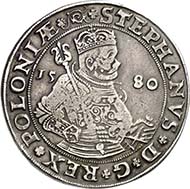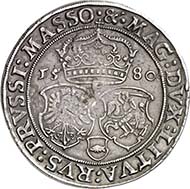07-03-2010 – 11-03-2010
Künker Auction in March
Künker Auction in March: Over eight million Euros for 6,840 lots
“The Russians are selling like hotcakes again”. That was the general consensus at the Osnabruck spring auction. This impression was borne out by hard facts in the final list of results including over 400 bidders live on the scene and 3,000 persons who submitted written bids shortly thereafter. Among the 705 Russian lot numbers, 690 were sold, outbidding estimated prices by some 84 percent, not to mention the “cherry on the cake “, estimated at 60,000 Euros, which garnered a stunning 70,000 Euros. Featured was a historically significant set of 17 medals from the Demidov Family. However, this was not even enough to clinch first prize within the vast offering among the four categories from 165 to 168. The most expensive piece, sold for 80,000 Euros (estimated value and hammer price), actually came from Poland – it was Stephan Bathory’s absolutely rare thaler dated 1580.
The overall results of the second week of March added up to 8.3 million Euros (estimated at: 6.3 million Euros). 6,840 items, representing over 96 percent of the range on offer, were sold, and only 249 lots went into the post-auction sale. It was definitely not detrimental to the success that a portion of the goods were still on display in the new Munich office (at the existing address) shortly prior to the auction. Künker’s customer-friendly services also include the fact that a feature topic in Catalogue 165 is also available as a special catalogue: “Baptismal thalers and baptismal medals, the Collection of W.R. Fassbender” may be downloaded at www.kuenker.de as a 91-page PDF file – naturally free of charge.
The “plums” in the Osnabruck auction “cake” were too numerous to mention. A few examples include Dadler’s attractive 1826 golden baptismal medal from Augsburg, hammer price 4,200 Euros (estimate: 3,000 Euros). The lot of 205 medals and jetons, completing the topic of baptismal thalers and medals, exceeded its estimated value by 1,000, fetching 16,000 Euros. Not a single piece from the Fassbender Collection was left unsold. What was literally a heavyweight lot in the entire week-long auction was No. 2754 with 25 albums entitled “Germany and around the World”: The bidding on 5,100 coins, estimated at 45,000 Euros, reached 65,000 Euros.
Some price estimates were exceeded many times over. An 1828 copper lepton from Aegina, estimated value 250 Euros, achieved a hammer price of 4,800 Euros, an undated Irish farthing (ca. 1674) sold for 5,500 Euros rather than its estimated 1,250, and a 1535 Gdansk szostak (German: Sechsgröscher) changed hands for an incredible 23,000 Euros rather than the anticipated 2,500. While an 1881 Romanian 5-lei piece exceeded its estimated price by a factor of five for an even 10,000 Euros, the estimate for a Bohemian denarius from Boleslaus IV Chrobry had to be raised by a factor of 18: 18,000 Euros. As one can see: it was an exciting week.
How did things fare in Osnabruck for the major collection areas – or “pieces of cake”, staying with that metaphor? Many buyers proved hungry for Medieval coins. A denarius from Charlemagne from Bourges fetched 7,500 (estimate: 5,000) Euros, a denarius of Touraine from the 10th Century was sold for 4,800 (3000) Euros, and a Regensburg denarius of the 1st type under Henry IV went for 4,800 (1,000) Euros. A delectable “sliver of cake” proved to be the gold Euros – all 436 commemorative coins attained mostly three-figure hammer prices, and there were several, namely French Euros, however, that even reached four figures. And who would believed: Coco Chanel. The 5-euro coin struck two years ago commemorating this fashion icon fetched a remarkable 6,100 Euros compared to its estimated 200 Euros.
The significant Ireland collection almost sold out completely, surpassing its total estimated value of 80,000 for 195 lots by over 60 percent at 134,000 Euros. Contributing to this success was an undated groat (1460/1463) which fetched 3,800 Euros (estimate: 1,250 Euros). There were similar success stories from the areas of Saxony, Prussia or Brunswick. Additional “plums”: The complete 46-piece collection of Bavarian history coins, or Geschichtstaler, reached 11,500 (8,000) Euros, a half ducat from Karlsburg dated 1759 and depicting Maria Theresia, offered at 400 Euros, finally commanded 6,000 Euros, and the bidding for a Peter the Great rouble, struck in 1721 in Moscow, surged to 12,000 (2,000) Euros.
With some 900 Greek and Roman pieces sold, the last piece of auction “cake” was served. An especially “tasty morsel”: a solidus by Valentinian III (425-455) for Licinia Eudoxia still managed to fetch 45,000 Euros (estimated value: 50,000 Euros), an eight aurii medallion of Claudius II Gothicus (268-270) far surpassed its estimated price of 4,000 Euros, reaching 54,000 Euros. – Additional details and results are available on the Web at www.kuenker.de.





